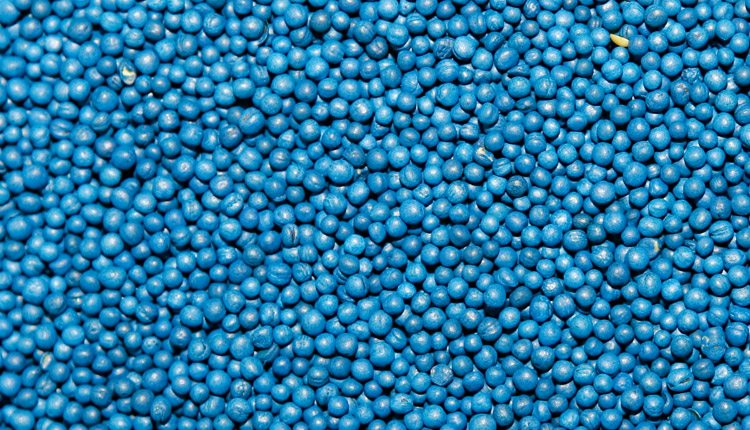On Jan. 1, 2017, only seed treatment operations, including mobile seed treaters, that are accredited under a new industry standard will have access to some seed treatments._x000D_
_x000D_
The Accredited Seed Treatment Operations Standard was conceived by members of CropLife Canada (CLC) as part of their commitment to lifecycle stewardship of their products; and in response to the Pest Management Regulatory Agency’s (PMRA) concerns about consistency amongst operators._x000D_
_x000D_
“In 2009, seed treatments and seed treatment application was a quickly growing sector and the investments were large,” says Russel Hurst, CLC’s vice-president of sustainability and stewardship, and the executive director of the Agrichemical Warehousing Standards Association. “But there was a very low level of knowledge amongst regulators of seed treatment application processes. Given the commitment of CLC and its members to lifecycle stewardship, the board of directors saw the opportunity to address the regulator’s concerns and to develop consistency and predictability for operators.”_x000D_
_x000D_
A multi-stakeholder committee was established to examine existing standards and to review labelling statements and provincial regulations to develop a practical standard that meets the needs of industry and regulators._x000D_
_x000D_
After four years of work, the CLC board approved the implementation of the Accredited Seed Treatment Operation Standards, administered by the Agrichemical Warehousing Standards Association._x000D_
_x000D_
When the standard was under development, there were concerns expressed by some seed growers, seed cleaners and retailers._x000D_
_x000D_
“At the beginning, there was the perception that everyone who treated seed was going to have to construct very expensive facilities,” Hurst says. “We knew that if we made the standard so rigid that nobody could realistically achieve its requirements, we would not be successful. As a result, I think what is being asked of seed treating operations is very achievable.”_x000D_
_x000D_
The Standard_x000D_
_x000D_
The standard comprises 76 auditable protocols in seven categories:_x000D_
_x000D_
Siting and Exterior Requirements – Eight protocols focus on facility location, including distances from environmentally sensitive areas, access for firefighters and external lighting._x000D_
_x000D_
Building Structure and Equipment – 19 protocols focus on buildings construction, ventilation and lighting, fire resistance, containment systems, and safety and maintenance of equipment._x000D_
_x000D_
Operations – 10 protocols deal with the provision of personal protective equipment, emergency equipment and supplies, safety around facility maintenance, labels and storage and disposal of empty containers._x000D_
_x000D_
Training – 10 protocols outline employee training requirements including safe operating procedures, transport of dangerous goods, labelling, equipment operation, first aid and emergency response training._x000D_
_x000D_
Documentation – 15 protocols deal with clear documented authorization from regulators and authorities around location, use and management of water, construction and ventilation; and the development of written procedures for the operation, management and safety of the operation._x000D_
_x000D_
Forty of the 76 protocols are designated mandatory. That means an operation must comply with them completely to be accredited. Most of the mandatory requirements are already required as part of fire, health and safety and building code regulations._x000D_
_x000D_
Thirty-two of the protocols are scored, with elements carrying between 10 and 30 points. In its official audit, the operation must achieve 80 per cent of the total available points in each section of the standard. The remaining four protocols are recommended as best management practises._x000D_
_x000D_
From July 2014 to March 2015 CLC offered a pre-audit system and covered the costs of a pre-audit. Auditors visited 483 sites to help operations understand what, if any, changes would need to be made to comply with the standard._x000D_
_x000D_
Operations that went through the pre-audit and were found not in compliance with some of the siting and structural protocols were eligible for exemptions under six grandfather clauses in the standard._x000D_
_x000D_
For example, Hurst says: “Many of the existing seed cleaning plants are wooden structures. The code says the facility should be constructed of non-flammable material like concrete or steel. Under the grandfathering provisions, and after a pre-audit, these structures could have been given exemptions from that requirement, and with some fire proofing measures could be accredited.”_x000D_
_x000D_
Monica Klaas, general manager of Alberta Seed Processors, says the grandfathering provisions are important._x000D_
_x000D_
“Quite a few of our facilities are over 50 years old and are predominately of wood construction, which makes complying with the fire containment protocols complex and expensive,” she says. “But with the focus on risk management, I’ve had some discussions of alternatives to massive capital expenditures, such as using a fire resistant material to clad a wood structure.”_x000D_
_x000D_

_x000D_
The State of the Sector_x000D_
_x000D_
According to Hurst, a gap analysis done at the conclusion of the pre-audits identified that about one-third of the 483 pre-audited sites have very little to do to comply with the standard, and some were even ahead of it. Many of the operations in this group were already certified under other AWSA programs._x000D_
_x000D_
Another one-third of the pre-audited sites are close. “They may need a few adjustments, but should quite easily be able to comply,” he says._x000D_
_x000D_
However, the other one-third will have substantially more to do. “This group of operations had not had anything asked of them before,” he says. “Most of the requirements will be for greater documentation, but there are some structural requirements. For example if you are treating seed on a dirt floor with poor ventilation, you will need to make some changes.”_x000D_
_x000D_
He says a lot of work was done to help this last group through the process. “We took the time to walk them through the requirements, and offer different options to comply,” he says._x000D_
_x000D_
Industry’s Reaction_x000D_
_x000D_
Brent Collins, director of cereals marketing at Bayer, says the company supports the industry accreditation system._x000D_
_x000D_
“A proactive approach to further improve processes and practises is always more desirable than the alternative,” he says. “Ensuring that commercial seed treatment processes follow this mindset will be beneficial in the long run.”_x000D_
_x000D_
Collins says that all of Bayer’s internal treating facilities are in compliance._x000D_
_x000D_
“Although Bayer’s current Western Canadian seed treatment portfolio does not currently contain any products that would be subject to the standard, we do encourage commercial treaters to be in accordance with the new operations standard,” he says._x000D_
_x000D_
Alberta Seed Processors’ Klaas says her members have been involved throughout the development process. “Our association had a representative on the consultation committee,” she says. “We promoted the pre-audit process with our members because we believed it was a great way to get a third-party assessment to help them make a decision on whether to proceed with any capital investments that would be required to be accredited. Thirty-four of the 40 facilities that apply seed treatments participated in the pre-audit program.”_x000D_
_x000D_
The program has some “good sense” elements to it, even if a business decides not to become fully accredited, Klaas adds._x000D_
_x000D_
Todd Hyra, SeCan’s business manager for Western Canada says that many of SeCan’s independent seedsmen members are working toward compliance, but initially had some concerns._x000D_
_x000D_
“There were concerns raised by independent seedsmen that the cost of potential upgrades would be difficult to recoup,” he says. “SeCan had guest speakers at our fall business meetings to review what needed to be done._x000D_
_x000D_
“Our members learned that most of the upgrades were just good stewardship or management practises, and in many instances there were economical ways to reach compliance with the requirements.”_x000D_
_x000D_
SeCan also encouraged members to participate in the pre-audit process to ensure they had the information they needed to make a decision about accreditation with ample time to make the changes that would be required to be in compliance with the standard._x000D_
_x000D_
One of SeCan’s members, Chris Ens of Ens Farms and Ens Quality Seed in Manitoba says his operation is almost ready to seek accreditation, but it has been a fairly onerous task. “We went through the pre-audit process and it was helpful; however, it is a great deal of work for the 10 to 20 days a year that our facility is used,” he says._x000D_
_x000D_
One thing that could be improved is the coordination of information, Ens points out. “We have asked a lot of questions and at times have difficulty getting answers, and sometimes the information from our auditor conflicts with what we receive from the people in charge,” he says._x000D_
_x000D_
Rod Merryweather, FP Genetics CEO, estimates that about one-third of seed growers will likely choose not to seek accreditation._x000D_
_x000D_
“They are not treating with seed treatments and do not plan to in the future so do not need to implement the program,” he says. “However, our shareholders who do treat seed are fully supportive of the program and see the value of the new regulations._x000D_
_x000D_
“Some are building larger warehouses and seed treating facilities to prepare for the sale of additional seed applied technologies and other crop inputs if that fits their future business model.”_x000D_
_x000D_
Mobile Treaters Must be Accredited _x000D_
_x000D_
Mobile seed treating operations are a large part of the sector, and they too must be accredited. Hurst says, while mobile treaters will not be required to comply with the siting and structural protocols unless they have permanent storage facilities, their process systems will still need to comply._x000D_
_x000D_
“Mobile treaters still need to meet health and safety requirements. They still have to prove that product is being properly and safely stored, training has been provided, as well as personal protective equipment,” he says. “They will also need to ensure that all documentation and operational plans are complete and available.”_x000D_
_x000D_
What is a Designated Product? _x000D_
_x000D_
Only operations that wish to treat seed with “designated products” will have to be accredited. It will be enforced by a “no ship” policy, which means starting Jan. 1, 2017, designated products will not be provided to a seed treater unless an accreditation number is provided._x000D_
_x000D_
Designated products are identified by the product registrant. When products are registered, the intended use must be identified. Designated products to which the standard will apply are those that are labelled for commercial use. Commercial use is defined as “treating seed for sale or gain.”_x000D_
_x000D_
“A list of designated products will be available on the AWSA website,” Hurst says. “The list will expand as registrants choose to designate new products for the commercial seed treating sector.”_x000D_
_x000D_
What About On-Farm Treating?_x000D_
_x000D_
Products that have a use statement on the label identifying them for use on farm will not be subject to the standard. Hurst says: “It has always been our policy that the standard would not reach the on-farm treatment segment. Farmers will continue to have access to non-designated seed treatments, and to seed treated by a commercial treater, but likely have never had access to treatments labelled for commercial use to treat seed on farm.”_x000D_
_x000D_
What Next?_x000D_
_x000D_
Hurst is confident that most commercial seed operations will be ready Jan. 1. However, operations can seek accreditation at any time. “Our 31 auditors will continue to be facilitative, working with operations to help them understand options for achieving accreditation,” he says. “We are developing, and will maintain, a dynamic website that lists auditors and designated products._x000D_
_x000D_
“New communication and training materials are being developed and updated. We are working with Ridgetown College to develop online training courses, and the program itself will be continuously monitored by a stewardship leadership committee to ensure that we are accomplishing the goal of environmental stewardship in_x000D_
a way that can be managed by the industry.”











